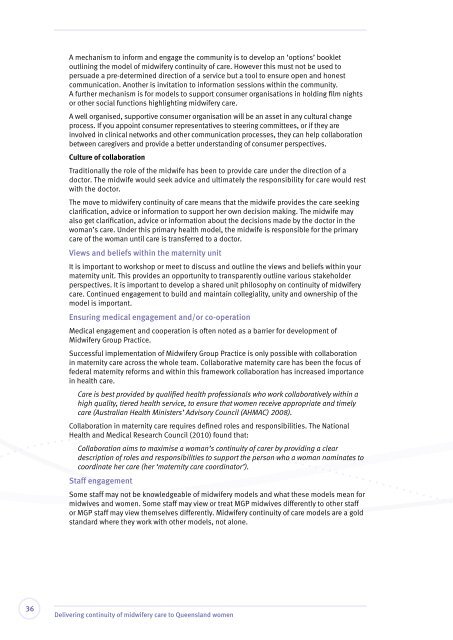Delivering continuity of midwifery care to Queensland women
Delivering continuity of midwifery care to Queensland women
Delivering continuity of midwifery care to Queensland women
You also want an ePaper? Increase the reach of your titles
YUMPU automatically turns print PDFs into web optimized ePapers that Google loves.
A mechanism <strong>to</strong> inform and engage the community is <strong>to</strong> develop an ‘options’ booklet<br />
outlining the model <strong>of</strong> <strong>midwifery</strong> <strong>continuity</strong> <strong>of</strong> <strong>care</strong>. However this must not be used <strong>to</strong><br />
persuade a pre-determined direction <strong>of</strong> a service but a <strong>to</strong>ol <strong>to</strong> ensure open and honest<br />
communication. Another is invitation <strong>to</strong> information sessions within the community.<br />
A further mechanism is for models <strong>to</strong> support consumer organisations in holding film nights<br />
or other social functions highlighting <strong>midwifery</strong> <strong>care</strong>.<br />
A well organised, supportive consumer organisation will be an asset in any cultural change<br />
process. If you appoint consumer representatives <strong>to</strong> steering committees, or if they are<br />
involved in clinical networks and other communication processes, they can help collaboration<br />
between <strong>care</strong>givers and provide a better understanding <strong>of</strong> consumer perspectives.<br />
Culture <strong>of</strong> collaboration<br />
Traditionally the role <strong>of</strong> the midwife has been <strong>to</strong> provide <strong>care</strong> under the direction <strong>of</strong> a<br />
doc<strong>to</strong>r. The midwife would seek advice and ultimately the responsibility for <strong>care</strong> would rest<br />
with the doc<strong>to</strong>r.<br />
The move <strong>to</strong> <strong>midwifery</strong> <strong>continuity</strong> <strong>of</strong> <strong>care</strong> means that the midwife provides the <strong>care</strong> seeking<br />
clarification, advice or information <strong>to</strong> support her own decision making. The midwife may<br />
also get clarification, advice or information about the decisions made by the doc<strong>to</strong>r in the<br />
woman’s <strong>care</strong>. Under this primary health model, the midwife is responsible for the primary<br />
<strong>care</strong> <strong>of</strong> the woman until <strong>care</strong> is transferred <strong>to</strong> a doc<strong>to</strong>r.<br />
Views and beliefs within the maternity unit<br />
It is important <strong>to</strong> workshop or meet <strong>to</strong> discuss and outline the views and beliefs within your<br />
maternity unit. This provides an opportunity <strong>to</strong> transparently outline various stakeholder<br />
perspectives. It is important <strong>to</strong> develop a shared unit philosophy on <strong>continuity</strong> <strong>of</strong> <strong>midwifery</strong><br />
<strong>care</strong>. Continued engagement <strong>to</strong> build and maintain collegiality, unity and ownership <strong>of</strong> the<br />
model is important.<br />
Ensuring medical engagement and/or co-operation<br />
Medical engagement and cooperation is <strong>of</strong>ten noted as a barrier for development <strong>of</strong><br />
Midwifery Group Practice.<br />
Successful implementation <strong>of</strong> Midwifery Group Practice is only possible with collaboration<br />
in maternity <strong>care</strong> across the whole team. Collaborative maternity <strong>care</strong> has been the focus <strong>of</strong><br />
federal maternity reforms and within this framework collaboration has increased importance<br />
in health <strong>care</strong>.<br />
Care is best provided by qualified health pr<strong>of</strong>essionals who work collaboratively within a<br />
high quality, tiered health service, <strong>to</strong> ensure that <strong>women</strong> receive appropriate and timely<br />
<strong>care</strong> (Australian Health Ministers’ Advisory Council (AHMAC) 2008).<br />
Collaboration in maternity <strong>care</strong> requires defined roles and responsibilities. The National<br />
Health and Medical Research Council (2010) found that:<br />
Collaboration aims <strong>to</strong> maximise a woman’s <strong>continuity</strong> <strong>of</strong> <strong>care</strong>r by providing a clear<br />
description <strong>of</strong> roles and responsibilities <strong>to</strong> support the person who a woman nominates <strong>to</strong><br />
coordinate her <strong>care</strong> (her ‘maternity <strong>care</strong> coordina<strong>to</strong>r’).<br />
Staff engagement<br />
Some staff may not be knowledgeable <strong>of</strong> <strong>midwifery</strong> models and what these models mean for<br />
midwives and <strong>women</strong>. Some staff may view or treat MGP midwives differently <strong>to</strong> other staff<br />
or MGP staff may view themselves differently. Midwifery <strong>continuity</strong> <strong>of</strong> <strong>care</strong> models are a gold<br />
standard where they work with other models, not alone.<br />
36<br />
<strong>Delivering</strong> <strong>continuity</strong> <strong>of</strong> <strong>midwifery</strong> <strong>care</strong> <strong>to</strong> <strong>Queensland</strong> <strong>women</strong>
















